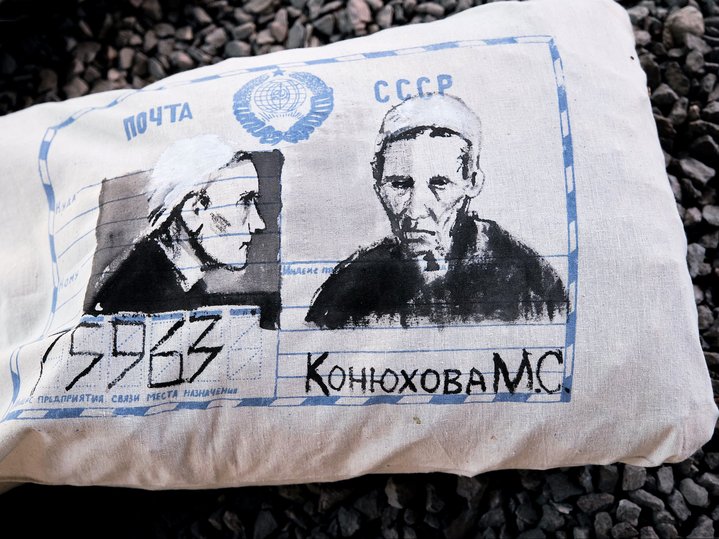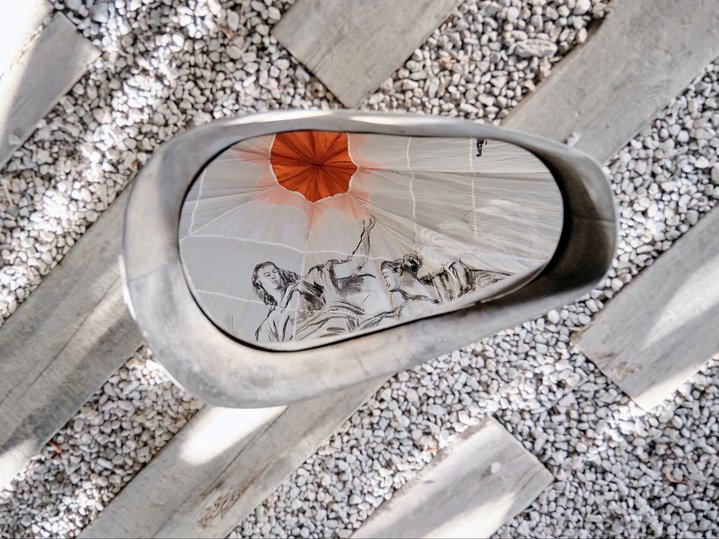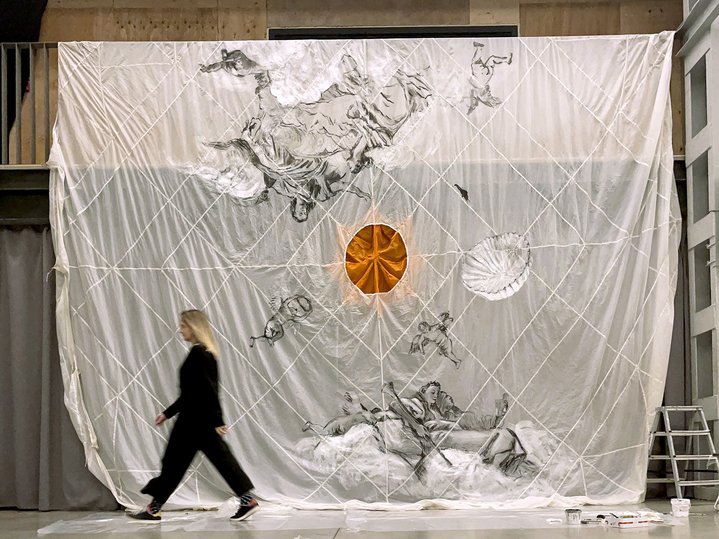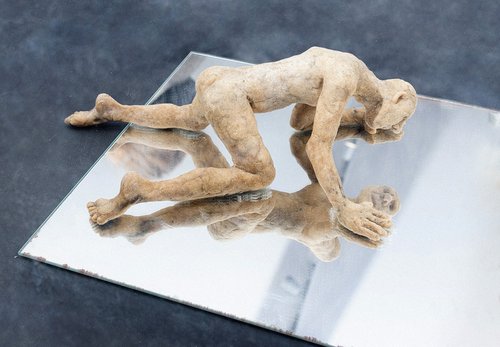Kovaleva on Tiepolo and Parachuting
Kovaleva’s solo exhibition 'Waiting Zone' has opened at the Gulag History Museum in Moscow. Full of the uncertainties of our troubled times, she asks us to look up at a phantasmagoric sky, populated with paratroopers and angels.
Katerina Kovaleva's (b. 1966) 'Waiting Zone' is an inaugural exhibition in the Pavilion of the Garden of Remembrance, a new space in the Gulag History Museum in Moscow. The prototype, designed by architect Dmitry Baryudin, was a seaplane hangar built in 1925 in the Solovetsky labour camp. Despite its size, simplicity and austere appearance the pavilion looks elegant. The daylight shines through the gaps in planks crossing the internal space making light and dark zones. It is not easy to fit into such a well-defined exhibition space, but Kovaleva has succeeded.
The waiting zone, as Kovaleva writes in her exhibition booklet, citing a Dictionary of Parachute Terms, is "the area of space in which the parachutist under the canopy must stay until the landing approach". The artist interprets the state of a parachutist hovering between the sky and the ground as a metaphor of our dependency on external circumstances, the time in which we find ourselves tied to the will of fate. "How does the speed of time change in the process of waiting? How does it affect the perception of our path, how does our soul depend on waiting? Do we feel calm or panic, are we forced to pause or do we feel the forced acceleration of time and of events? Does waiting help us to understand time?" these are philosophical questions that weigh on the artist’s mind.
She first showed an exhibition called "Waiting Zone" last August in Tarusa. "I had long wanted to make an exhibition not in a gallery or exhibition hall, but in some unusual place. I was thinking about a field, a forest, or an abandoned house. And a friend of mine told me about a ruined eighteenth century salt barn in Tarusa, which was being restored", says Kovaleva, "Then I wanted to show the exhibition in Moscow and was lucky enough to show it here at the Gulag Museum. And I made two eight-metre parachutes with fragments of allegorical frescoes by Tiepolo for this space".
These parachutes with images of half-naked nymphs and chubby angels are in the style of work Jean Baptiste Tiepolo (1696–1770): "The Triumph of Art, or the Art of Waiting" and "The Punishment of Apollo, or Waiting for Love". These have becme the semantic core of the exhibition and its most spectacular exhibits. "It seems to me that the dome is a guardian angel on the one hand and a symbol of waiting on the other. Tiepolo has long been ingrained in my heart, I don't know why. And with the parachutes, I wanted to create an echo of his famous works. Tiepolo's plafonds are a fantastic sky theatre, inhabited by deities, angels and people, a sky full of flesh. And it is Tiepolo's figures that give the parachutes the feeling of a dome". Images of parachutes and parachutists are also painted on several acrylic and synthetic canvases hung in the pavilion space. Among them is 'Apollo on a Parachute', not an ironic work but just aesthetically beautiful,understandable in the context of the exhibition.
But the subject of Tiepolo and the parachutes is not the only one on it. The second has to do with the direction of the museum, where the 'Waiting Zone' takes place. In the centre of the pavilion hangs a chandelier made out of barbed wire. Beneath it are buckets with mirrors that mimic water and reinforce the sense of desolation and despair that the installation 'If It Rains' makes you feel. "In Tarusa we were going to do an exhibition in winter and I wanted to make an ice chandelier so it would melt and start dripping and we would set up buckets. And the viewer, going into that space, had to feel uncomfortable passing through it."
The third and final part of the exhibition calls forth another meaning of the word 'waiting zone'. The series of works on paper called 'On Suitcases' consists of small sheets of paper in black watercolour depicting moody people sitting on chairs with suitcases and trunks. "These drawings were made in winter and are not directly related to the exhibition, but I wanted to link the exhibition with the museum. This is how the chandelier made of barbed wire, which was brought froma camp in Tomsk appeared, and the crystals on it are from real chandeliers, they depict flowing water," explains the artist.
Katerina Kovaleva is a mature, established artist who has worked in different genres and techniques, made drawings, collages and sculptures, and participated in the First Antarctic Biennale, organized by Alexander Ponomarev in 2017 aboard a research ship. In 2018 she had a solo exhibition at the Moscow Museum of Modern Art. "Waiting Zone" shows that Kovaleva never tires of searching for new themes, subjects and creative answers to the most challenging questions.















